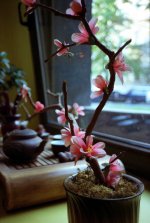Given the above - I am wondering whether you would expect less grainy results from shooting ISO 400 @ 400 or ISO800 @ 400 ... ?
The amount of grain depends on exposure, and on film asa. If you give both films as much light as they need for optimal results, of course the 400 will have smaller grain.
The thing is that for in camera metering, there's no such thing as shooting at an asa, because you end up doing what your meter or your guess for compensation tells you...
Personally I use Portra400 for low light, but I give it the light it deserves. I give all my C41 a +2 when metering incident (so 100) with warming filter. On auto in camera I set asa at +2/3, that's, for example, 64 for Ektar (25 incident with warming filter).
I use Portra800, an amazing film, for stopping down a bit in low light, and I usually push it two stops. It doesn't mean you can gain real speed until 3200, no, it means that's a film designed for great color after what labs know as push2, but you gain less than a stop... For a push2 I meter it incident at +1/3, so 640 (warming), and in camera auto at -1, that's 1600 with filter.
Metering is this complicated if you are not sure about what to do. It is this easy when you know what to do. I meter slide film and B&W differently. Also, when an incident metering says 1/250 at f/8, it doesn't mean the same that when a camera gives that reading.
But if you try the above settings for standard and pushed C41, you'll see they are very precise. I do it with all C41 films, no mater the brand or asa. Check it and tell me what you think then...
Cheers,
Juan


